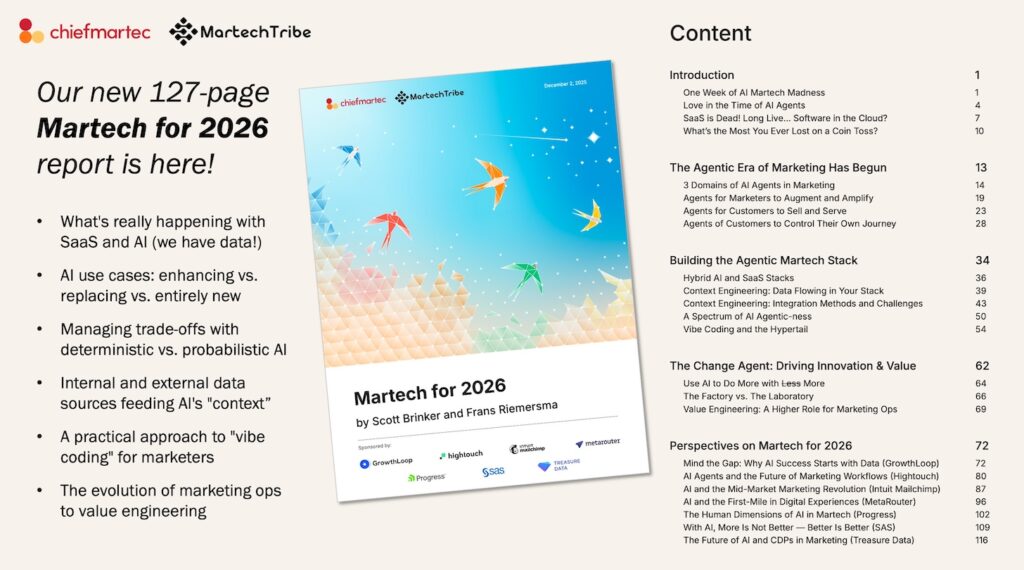
Bob Lord and Ray Velez, respectively the CEO and CTO of digital agency Razorfish, teamed up to write a book on the intertwining of marketing and technology. It’s called Converge: Transforming Business at the Intersection of Marketing and Technology.
How could I not love such a book?
Actually, Bob Lord is now the former CEO of Razorfish. He was recruited away for the job of CEO of AOL Networks earlier this summer by Tim Armstrong. But before then, he and Ray had the benefit of over a decade of experience together at Razorfish, delivering technology-powered marketing to clients such as Delta, Kellogg’s, Mercedes-Benz, and Nike.
The book covers a wide range of topics at this intersection including:
- next-generation storytelling and the birth of the creative technologist
- data-driven experiences and the road to better targeting in marketing
- the impact of cloud computing on marketing’s capabilities
- how ubiquitous computing, including the quantified self, will effect marketing
- how to adapt your organizational structure to better deal with convergence
- how to use agile methodologies to address convergence in your company
I interviewed Ray over the phone — part of a virtual book tour they’re doing (see the next stop at Denise Lee Yohn’s blog) — and we talked about some of the larger themes that had emerged out of the book.
I’m particularly fascinated by how this convergence is changing the culture of marketing. Ray believes there are two main effects on culture. First, marketing is becoming more collaborative than ever before — many different kinds of talents working together — with data scientists and technologists in the room with traditional creatives and business people. Second, the customer is at the center of everything marketing does.
He admitted that it sounds simple. Of course, the customer would be at the center of marketing, right? But in the marketing of an earlier day, the customer was much more of an abstract idea. There may have been demographics and personas mapped out to help drive the creative and the media plan. But now, marketers are actually dealing with real, flesh-and-blood customers — individuals and communities — with whom they directly interact. It may sound simple in concept, but it’s a huge shift in the dynamics of the work.
The customer is the coordinating device for this grand new culture of collaboration.
So, what impact is convergence having on agencies?
Ray said that “agencies need to relinquish the idea that there’s this almighty creative director on high.” Creative is not the product of a single guru. Instead, creative directors work with a much broader team. They don’t produce creative at a single instant in time, from comps and storyboards sketched out in a room sequestered away from the world. Now, they’re producing data-driven experiences that evolve from feedback with those real, flesh-and-blood customers.
We spent a while talking about the Ray’s experience working with clients using an agile methodology. (Not familiar with agile? Here’s my introduction to agile marketing.)
One of his recommendations was to develop marketing staff who think like “product owners” more than marketing managers. A “product” might be anything that customers interact with — for instance, a website. These product owners play a crucial role in the agile method, helping to drive the prioritization of work to be done on behalf of their audience. Ray sees this as far more effective than committee-based approaches. Committees simply take too long to really harness the speed and flexibility of an iterative approach such as agile marketing.
Product owners are data-driven, but it’s through the lens of customer experience. The old metrics of marketing don’t necessarily govern this new mission. “Forget about reach,” said Ray. “Focus on features.”
These product owner roles can “push through the friction” and “be the evangelist” for the modern consumer. They can drive the tough prioritization choices and trade-offs. They can let their teams be iterative. And they can be the bridge between disparate groups such as marketing and IT.
For companies who question the scalability of an agile approach — can that really work in a large organization? — Ray recommended the book Scaling Lean & Agile Development by Craig Larman and Bas Vodde. He can also attest to this approach with many of the big brands that they’ve worked with. For instance, as the agency of record for Mercedes-Benz, they handled all work in an agile, iterative manner.
“It allows them to shift priorities more quickly,” Ray said. “You always need to be able to react to changes and the consumer voice.” At the same time, you don’t want to interrupt work in progress. The beauty of agile is that the small sprints of work, with “check in” points every couple of weeks, makes it feasible to adapt to changes quickly without derailing work midstream.
“You need to be relevant in a world where customers have choice and control.”
For more on Ray’s and Bob’s thoughts on the wonderful Reese’s peanut butter cup that is marketing and technology, pick up a copy of their book. If you’re at all like me, I’m sure you’ll enjoy it.



I read the first 2.5 chapters and had to put it down. The book is basically a bunch of rah-rah opinion spouting. Given, I hold most of the opinions spouted, but what I was hoping for was some well articulated vision of technology-driven marketing, buttressed by facts and trends that lead to new insights on how can improve my operation. Instead, there’s a lot of name-dropping and vanity metrics that produce little insights. Maybe it gets better, but the first few parts are just… so… bad.